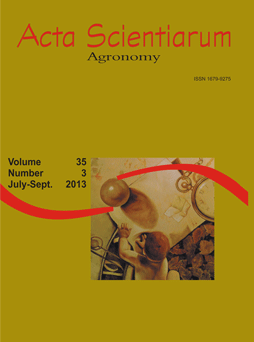<b>Characterizing zinc use efficiency in varieties of Arabica coffee</b> - doi: 10.4025/actasciagron.v35i3.16322
Abstract
Among micronutrients, zinc (Zn) is important for coffee tree cultivation, especially in the clayey acid soils of Brazil’s southeast region, where coffee production is an important activity. This study aimed to evaluate the Zn use efficiency of coffee tree varieties using two zinc concentrations. Seedlings of 11 varieties of coffee trees were grown in a greenhouse in nutrient solution containing either 0.0 or 6.0 µmol L-1 of Zn. After eight months, we evaluated the total biomass production, leaf biomass production, concentration of Zn in the plant organs, absorption efficiency, and Zn use efficiency. All characteristics were affected by the Zn concentration. The biomass production of apical leaves was most affected by the Zn treatments, with high variability for the studied varieties. The ‘IPR-103’ variety had the highest Zn use efficiency, and the ‘San Ramon’ and ‘San Bernardo’ varieties had the lowest Zn use efficiency. The ‘Rubi’ variety had a high and low Zn use efficiency when grown at 0.0 and 6.0 µmol L-1 of zinc, respectively. The ‘Oeiras’ variety had a low Zn use efficiency when cultivated at 6.0 µmol L-1 of zinc. The other varieties studied were moderately efficient in their use of zinc.
Downloads
DECLARATION OF ORIGINALITY AND COPYRIGHTS
I Declare that current article is original and has not been submitted for publication, in part or in whole, to any other national or international journal.
The copyrights belong exclusively to the authors. Published content is licensed under Creative Commons Attribution 4.0 (CC BY 4.0) guidelines, which allows sharing (copy and distribution of the material in any medium or format) and adaptation (remix, transform, and build upon the material) for any purpose, even commercially, under the terms of attribution.




















































